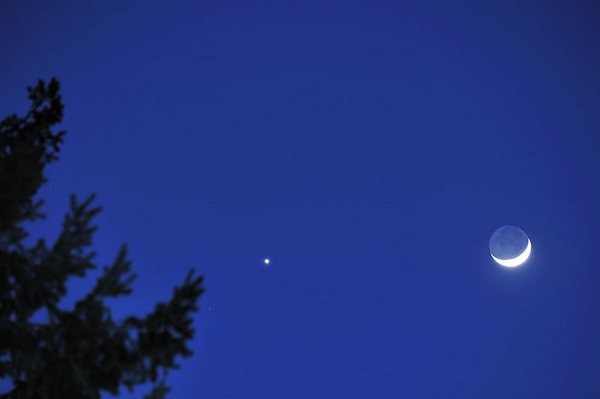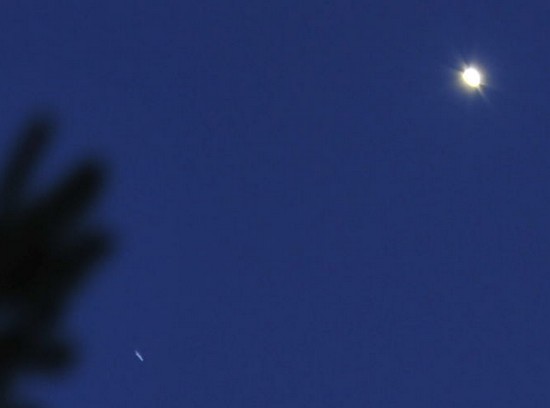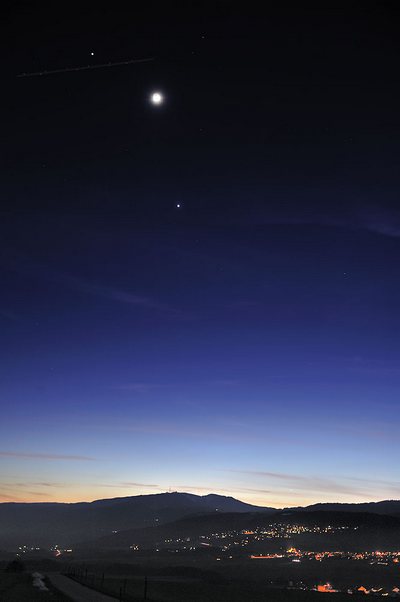There have been a some wonderful sights in the evening sky these past few nights – the Moon, Venus, and Jupiter in unusually close conjunction. Photogenic stuff!
Unfortunately, getting good photographs of them is not easy …
- In general the light is low so you need a long exposure
- But the Moon is still very bright. Think about it. The Moon shines because it reflects the Sun’s light. So the illuminated part of the Moon is as bright as a scene on a sunlit day
- This means that, if you use a shutter speed which is too long, the illuminated parts of the Moon will burn out
- And, to add to a photographer’s woes, the stars and planets are moving. So – again – if you use a shutter speed which is too long they will start coming out as streaks
- Finally, it is usually best to have something else in the image to give a sense of depth and scale
What to do?
As with most things photographic, you have to compromise. Here’s a photograph I took of the Moon and Venus, with a 300mm lens. I don’t think it’s a particularly good photograph, but it illustrates my points …

The first compromise is to choose when you take the photograph. You want a time when there is still enough light in the sky so that it comes out a rich colour. If you wait too long the sky goes black and boring, and surrounding objects like trees disappear. On the other hand, if you take a photograph too soon the sky will be way too light. In my experience, from 45 minutes to an hour after sunset is the best time. The sky may appear almost black to your eyes, but your camera will pick out the colour. This photo was taken 45 minutes after sunset.
The second compromise isn’t really a compromise – what shutter speed to use? That will be dictated by the amount of light available and the aperture setting of your lens. This photograph was taken with my lens at f8 and a shutter speed of 5 seconds. (You can’t get away without using a tripod in this game.)
A shutter speed of 5 seconds is about the maximum you can use without the stars coming out as streaks. Even at that speed it was beginning to happen. Here’s a bit of the photo at 100% …

You can see a solitary star has already turned into a line – they’re moving faster that you think – and Venus is beginning to smear. As for the tree: it’s a no-hoper. The wind was blowing it around madly, so blur is the order of the day.
At f8 I had some aperture to spare, so I could have opened it up a bit to increase the shutter speed. But one thing I would not recommend in a situation like this is to bump up the ISO. Already, with low light levels and long exposures, you’re going to get digital noise. You can see it in this image. Higher ISOs will just accentuate that.
You have to compromise. And here’s another compromise I took an hour after sunset, the next day …

A 6-second exposure at f4. The two planets are rather small. And the Moon was still a crescent, not a blob of light. So … Moonrise over Hernandez it’s not.
But I like it anyway.

Bravo, Alistair specially loved the moon crescent
This will teach me a lesson to check with your site more often!!!!
I was trying to catch that moon and star lineup from down here where the STARS are even brighter
but failed.
Will have to wait some zillion years for a next chance
Albest to you and your wife,
Mavis
Thanks Mavis.
You won’t have to wait ‘some zillion years’. There will be another very close conjunction of the Moon, Jupiter and Venus in the evening sky on 20th June 2015.
Get your camera ready 🙂